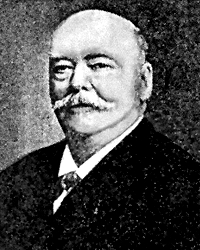Maurice Leblanc (engineer): Difference between revisions
Appearance
Content deleted Content added
(changed "entitles" to "entitled" in second paragraph) |
No edit summary |
||
| Line 13: | Line 13: | ||
* a means of converting electrical signals back into light |
* a means of converting electrical signals back into light |
||
* a screen for viewing the image |
* a screen for viewing the image |
||
Leblanc was awarded the [[Poncelet Prize|''Prix Poncelet'']] for 1913 by the [[French Academy of Sciences]].<ref>{{cite journal|journal=Bulletin of the American Mathematical Society|title=Poncelet prize|page=p. 40|volume=vol. 20, Oct. 1913 – June 1914|url=http://books.google.com/books?id=RQwPAAAAIAAJ&pg=PA40}}</ref> |
|||
==References== |
|||
{{reflist}} |
|||
==External links== |
==External links== |
||
Revision as of 19:30, 20 October 2014

Maurice Leblanc (1857 – 1923) was a French engineer and industrialist.
Born in Paris, Leblanc worked primarily in improving induction motors and alternators. He also invented an improved vacuum pump and worked in the area of refrigeration.
The December 1, 1880 French publication "La Lumière électrique", published an article by Leblanc entitled "Etude sur la transmission électrique des impressions lumineuses". In this article Leblanc outlined five functions required for a television system.
- a transducer to convert light into electricity
- a scanner to break up a picture into its constituent parts
- a method of synchronising the receiver and the transmitter
- a means of converting electrical signals back into light
- a screen for viewing the image
Leblanc was awarded the Prix Poncelet for 1913 by the French Academy of Sciences.[1]
References
- ^ "Poncelet prize". Bulletin of the American Mathematical Society. vol. 20, Oct. 1913 – June 1914: p. 40.
{{cite journal}}:|page=has extra text (help);|volume=has extra text (help)
